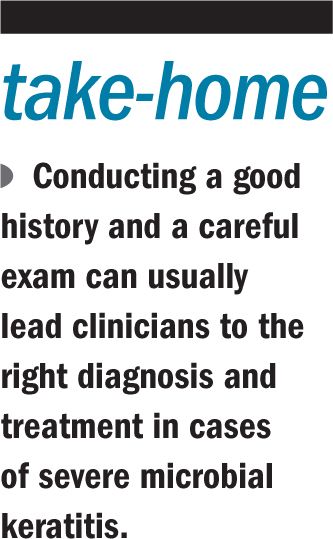Article
Prompt attention vital to managing severe corneal infections
Conducting a good history and a careful exam can usually lead clinicians to the right diagnosis and treatment in cases of severe microbial keratitis.
Reviewed by Christopher N. Ta, MD
Palo Alto, CA-Corneal infections are among the most serious reasons for ophthalmologic visits and require immediate attention.
“Early and accurate diagnosis is important for a favorable outcome for a patient with a severe infection of the cornea,” said Christopher N. Ta, MD.

Related: Why infections related to PK require intense vigilance
“It is the infection that can cause severe, irreversible loss of vision,” said Dr. Ta, professor of ophthalmology, Byers Eye Institute, Stanford University School of Medicine, Palo Alto, CA. “Infection is the number one thing to diagnose and the number one thing to treat.”
But infections differ. Different etiologies, different organisms, different susceptibility profiles, different diagnostic and treatment resources, and other factors all play roles in clinical decision making.
More: Tracking the best treatment for fungal keratitis
Diagnosis and treatment are relatively straightforward in academic centers and larger cornea specialty clinics. Take a history, perform an examination and take scrapings from the cornea, send the scrapings for culture, identification and susceptibility testing and treat as indicated by the results.
“That’s the ideal, but we all recognize that immediate laboratory support may not be available in every ophthalmology clinic,” Dr. Ta noted. “A good history and a careful exam can usually lead you to the right diagnosis and treatment.”
Related: Photoactivation holds promise for keratitis treatment
Identifying risk factors
Identify risk factors
Bacteria are the most common infectious agents affecting the cornea, he continued.
Contact lens wear is far and away the most common cause of corneal infection, most often secondary to Pseudomonas aeruginosa. Progression is typically rapid.
Other common risk factors for corneal infection include trauma to the eye and post-operative infections. Following ocular injury, Gram-positive bacteria, including various strep and staph species are common, as are fungal infections.
Recent: Why fungal infections after keratoplasty are on an upswing
Streptococcus pneumonia infections tend to produce deep central ulcers with hypopyon. Progression is rapid and the risk of corneal perforation is high. Staphylococcus aureus infections may be treatment-resistant to various antibiotics, including methicillin-resistant Staphylococcus aureus (MRSA).
Less common risk factors include sutures or other foreign bodies in the eye, neurotrophic keratopathy, autoimmune disorders, dry eye, and eyelid abnormalities.
Other infectious agents include herpes virus and acanthamoeba. Herpes infections are usually recurrent and present in the setting of a neurotrophic cornea and vascularization. Acanthamoeba infections are usually associated with contact lens wear.
Recent: Analyzing Acanthamoeba contact lens danger
The first step in any evaluation is a complete history to help identify potential causes and organisms. If laboratory identification is available, use a spatula to scrape the base of the ulcer. The scrapings are inoculated directly onto culture media.
Bacteria are the most likely agent in eye infections and scrapings can be inoculated onto blood agar, chocolate agar, and a broth media. Brain-heart infusion or Sebaroud’s media are used to isolate fungal infections.
Video: Determining the proper intracameral moxifloxacin dosage
If a herpes infection is suspected, scrapings can be sent for polymerase chain reaction (PCR) analysis of viral DNA fragments. Acanthamoeba testing requires a special media with live bacterial cultures, such as non-nutrient agar with E. Coli overlay. Confocal microscopy are also sometimes used to identify fungal and acanthamoeba infections.
Because bacteria are the most common infectious agents affecting the cornea, it is usually appropriate to begin empiric treatment with topical broad-spectrum antibiotic. If the ulcer is small, peripheral and does not threaten vision, hourly application of a commercially available fluoroquinolone is a good first step. Typical agents include besifloxacin and moxifloxacin.
“If it is a large, deep, central corneal ulcer that threatens vision, some of us will advocate a fortified antibiotic that covers both gram positive and gram negative bacteria,” Dr. Ta added. “I would begin with a commercially available agent until you can get fortified antibiotics compounded.”
Role of compounding pharmacy
Role of compounding pharmacy
Ophthalmologists should know a local compounding pharmacy, he continued.
For infections that require agents, such as cefazolin, tobramycin or vancomycin, the compounding pharmacy converts an intravenous formulation to a fortified ophthalmic formulation.
Related: Ocular surface unfriendly to pathogenic bacteria
“If you have a patient with a MRSA infection of the cornea that is also resistant to fluoroquinolones, one of the very few antibiotics that could eliminate those organisms is vancomycin,” Dr. Ta said. “But vancomycin is not commercially available in an ophthalmic formulation. That’s when you need a compounding pharmacy to make it for you.”
If there is a high level of suspicion for fungal infection, it may be reasonable to begin treatment with both a broad spectrum antibiotic and topical natamycin, a broad spectrum antifungal. Treatment can be adjusted depending on culture and susceptibility testing.
Patients who have a history of chronic topical steroids are also at risk for herpes keratitis. Antiviral agents such as topical ganciclovir or oral acyclovir, valcyclovir or famcyclovir are effective treatment for herpes keratitis.
More: Gauging ganciclovir gel for herpes virus
“It comes back to taking a good history, making the diagnosis, and initiating treatment or referring patients to a cornea specialist if possible,” Dr. Ta said. “Most cases of cornea ulcers are caused by bacteria and can be treated empirically with broad-spectrum antibiotics. However, these patients need to be monitored very closely and if they don’t improve, referral to specialist care is very important.”
Christopher N. Ta, MD
E: cta@stanford.edu
This article was adapted from Dr. Ta’s presentation at the 2015 meeting of the American Academy of Ophthalmology. Dr. Ta did not indicate any proprietary interest in the subject matter.
Newsletter
Don’t miss out—get Ophthalmology Times updates on the latest clinical advancements and expert interviews, straight to your inbox.




